All about Sustainability
What is it all about?
Sustainability is a word everybody uses today. Everybody thinks it is important to be sustainable. But what does that actually mean? How can I be sustainable? What do I know about sustainability?
This series is about filling the word sustainability with some meaning, content and information. Therefore we will post something every month. It is important for us to also show some easy and practical possibilities to be sustainable. Sticking to that plan a practical experiment and a more scientific report about a recent topic take turns every month.
This is not about big new discoveries in science. It is not about life hacks that will totally change your life. It is about changing the world. Just a bit. Day by day, in daily life. Through knowledge and action.
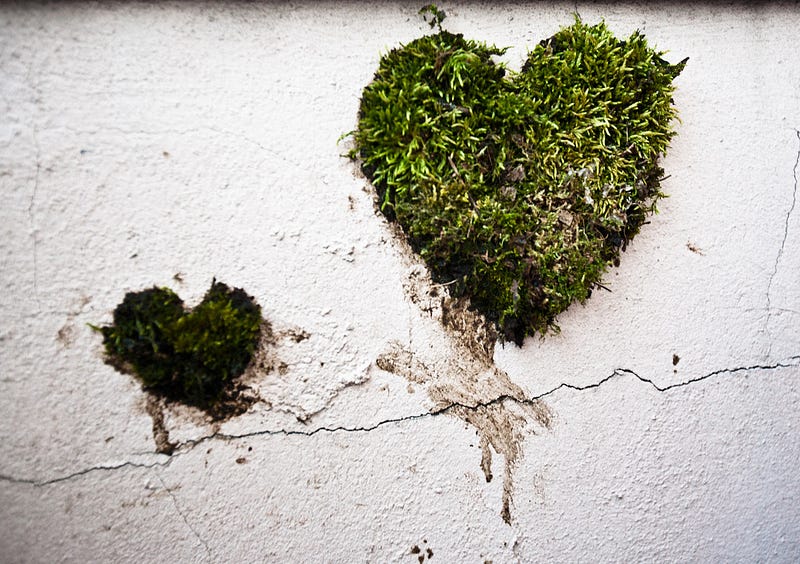
Microplastic
What is Microplastic?
Thanks to the disastrous pictures of whole islands of plastic waste floating on the sea, we are all aware of the problem caused by plastic.Plastic, produced by us. Used by us. Irresponsibly thrown away by us.
Plastic waste has a harmful impact on the environment and on animals, making it impossible for the animals to survive. Plastic disintegration is a long-term process, a process that lasts over many generations and once the plastic is in the sea, there are only few possibilities to accelerate this particular process.
Another problem, often underestimated, related to plastic waste is microplastics pollution. Microplastic debris is almost invisible to the human eye and more products than we think to contain them; only few people are aware of their existence and impact on our daily life.
According to scientists, microplastic is a piece of plastic smaller than 5 mm. However, many microplastics are smaller than one nanometer.
Microplastics can be classified into two categories: primary and secondary microplastics. Primary microplastics are produced as micro plastic and are useful for industrial use; they are also found in beauty products, such as shampoo and lotions. They are usually produced as pellets, which are spherical or cylindrical, with a diameter of less than 5 mm.This shape makes it easier to transport them and they can be converted to many different types and forms. This kind of microplastic has a physical and chemical impact on the marine environment, which is hard to measure due to several reasons.
Secondary plastics result from the degradation of bigger pieces of plastic like plastic bags or packages.
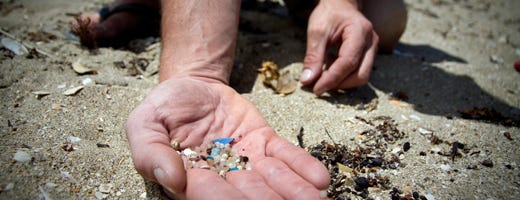
Sources of Microplastic and How They Occur
The plastic I am talking about is a subcategory of the chemical group of polymers. Polymers are long-chained molecules, usually made of fossil fuels. There are homopolymers and copolymers.The difference here is that due to specific chemical procedures, some polymers are made of one type of molecule (homopolymer) and some are made of different types of molecules (copolymers) . This has a major influence on analytic methods because it is harder to tell how the original plastic was constructed, once it has degraded.
Overall, there are five different types of plastic which are used most of the time and which are predominantly found in the ocean. Furthermore, here are also some plastics made of biomass. They are a good opportunity to solve the issue with exhausting resources. Nevertheless, these biomass-based polymers don’t solve the microplastic issues because they mirror the structure of fossil fuel based polymers and share therefore the same characteristics.There are even biomass-based polymers dissolving on its own without disturbing the ecological system that much but unfortunately, they are quite expensive and not efficient.
Fragmentation or Mineralization? The Weathering Progress
Plastic in general is hydrophobic: So its degradation is generally caused by UV-Radiation, heat, and oxygen and the process is fairly slow. The biomass-based plastics I mentioned before don’t have this characteristic and dissolve on their own; that is why they are less hazardous.
The usual degradation consists in the breakdown of long chained molecules into many molecules that no longer have the previous characteristics. However, these secondary microplastics, that need to be degraded before they occur, need different conditions. The process responsible for the specific degradation of secondary microplastics is called mineralization. Mineralization means that the structure persists, but the pieces of plastic become gradually smaller during the process. The chemical mechanism describing this mineralization is called photodegradation: UV-Radiation is needed and it is an autocatalytic oxidative degradation. For more chemical details click here.
This mechanism leading to the commonly weathering can be influenced in many ways. Some industries, for example, add heat stabilizers, antioxidants, and many other chemicals to improve the polymer’s characteristics. Moreover, several natural factors can influence the weathering: salinity, mechanical impact, temperature and other factors can accelerate or decelerate the process. Therefore, there are no reliable methods to clarify a microplastic piece’s source and its age. It is impossible to say how long a given piece of plastic has been polluting the ocean because it could either have been in the ocean for a short amount of time and have weathered very quickly or have been in the ocean for a long time and weathered very slowly. There are reliable methods, which only allow determining the level of degradation at the beginning of the process but no methods for a longer duration.
Also, there are different kinds of polymers. The most used are thermoplastic, elastomeres, and duroplastic. Thermoplastics are long chained polymers without any connection between their chains; chains are held together only by Van Der Waals interaction. Therefore, polymers can lose their integrity very easily by being heated. The chains move past each other, the polymer becomes liquid and the interactions get weaker. Once it is cooled down, you can create new forms with the same polymer. Elastomers have loose connections between their chains.That enables the polymer to be stretched but it is also not heat-resistant. Duroplasts have strong molecular connections between the chains. Therefore, it is heat-resistant up to very high temperatures. But on the other hand, you can not reshape it. Once it has a shape, it stays like that.

Nevertheless, you can recognize with your naked eyes the progress of weathering/mineralization: it discolours, the debris of plastic becomes weak and brittle. Any mechanical force (e.g. the wind, waves) can break the fragments into even smaller pieces.
A beach for an example is very helpful for the weathering process because of the high amount of UV-Radiation, the mechanical impact through wind and waves and the subsequent abrasion leaved that out.
All in all, it is hard to analyze comprehensively analyze one particular piece of microplastic because of the named reasons. I will go deeper into that topic in the next passage.
Analyzing microplastic:
The analysis of microplastic is one of the most complex but also most important tasks. It is crucial for further investigations and actions against the pollution by microplastic. First of all, it is important to know that wherever a sample had been taken, microplastic was found. So you can basically say that microplastic is present in the whole marine system and also onshore. That’s why it is important to find the hotspots of microplastic appearance as well as the sources of microplastic. In consequence, scientists try to remodel the paths of microplastic and do a lot of statistic work. The aim is to be able to tell the total amount of microplastic in the ocean and onshore, and also to be able to reconstruct an individual micro plastic’s path by analyzing it.
There are three different substances that need to be analyzed to find microplastic: You can take water samples, sediment samples and also examine the biota.
Analyzing water samples is more difficult than the usual for other purposes because you need a higher amount of water to have a representative result. Also, the kind of microplastic you will find depends on the nets and filters you are using . There is also the possibility to take samples from only the surface. This influences the results in another way because the examination only happens in a two-dimensional way and does not consider the debris of microplastic, which has already sunken. Sometimes plankton samples are used or even turned into a net because microplastic gets entangled in plants. In general, it is very hard to tell how deep microplastic sinks and on which level in space the most microplastic can be found, but scientists can say for sure that microplastic sinks between 10 and 150 meters per day. So after taking a sample, the debris has to be somehow separated from other substances. In order to do this you use density separation systems (e.g. this one.) and also certain chemicals. Then the debris can be dried, weighed and analyzed. It is important to weigh it to achieve an overview of the total amount. Under a microscope, you can analyze debris until the size of 10 μm. There must be even smaller pieces, but until now it is impossible to analyze them properly.
Given the fact that with a developing plastic industry there is a huge variety of different types of microplastic there are more possibilities of the original composition of one debris.
Some pieces are easier to analyze. For example, a huge amount of microplastic is going into the sea directly, while it is being transported by ship. Also, you can redirect some microplastic hot spots to specific industry sector in certain areas.
There are two different options for analyzing sediments. Scientists examine sediments from the coast line and from the seabed. Examining sediments from the seabed is very elaborate but seems to be a good possibility to find out anything about microplastic in the deep sea. Usually, different kinds of sieves and chemical procedures in the laboratory are necessary to separate the debris and analyze it under the microscope, just like the samples from the sea.
Analyzing samples from biota, especially from animals is also very important because, on the one hand, it is important to examine the influence of microplastic on the animals and on the other hand, animals can transport pieces of microplastic for a certain distance and influence their path through the ocean.
All in all, it is hard to tell where the highest amount of microplastic can be found. Nevertheless, further investigation are a key because they make it easier to prevent further pollution and it also makes sense to start cleaning certain hot spots.
Therefore scientists are creating models and predicting a specific debris’ path through the ocean. A piece of microplastic is usually a passive tracer. It is influenced by the sea flow and any other mechanical influence. It is a lot of statistic work, given the fact that right now there is only information about various types of microplastics on several spots, but no record about one specific piece of microplastic. Also, there are some factors that are hard to predict. For example, animals transporting the debris or unexpected weather issues. But once the scientists are able to reconstruct and predict a piece of microplastics’ path it will be easier to prevent the pollution.
Effects of Microplastic on the Marine Environment
The physical and chemical impact of microplastic on the marine environment is a relatively new field of research and many phenomena are not yet well-known or even discovered. Right now, scientists are estimating the risks of microplastic of any kind. The risk level is defined by hazard and exposure. Depending on these factors, different kinds of microplastics have different risk levels. A kind with huge hazardous impact and an enormous exposure has the highest risk. In general, you can say that the smaller the particle is, the more dangerous it is.
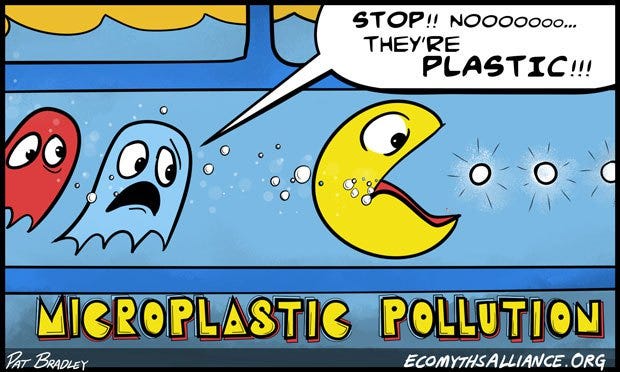
That is because the smaller the particle, the bigger the surface area per unit mass, and also it can more easily enter animals through gills and cells but the biggest amount is absorbed by consumption. Physically, particles can cause hazard passing the organs and also entangle in algae and other water plants. Also, it can have an influence on the animal’s feeding. An accumulation of debris can cause the feeling to feel sated and therefore influence the fish’s nutrition behaviour.
There are some more biological effects: If the size of a debris is smaller than 0,25 mm it can cause the breakdown of the membrane of lysosomes. These are cells that are responsible for dissolving the biopolymers. After the breakdown, degrading enzymes are released into the cytoplasms and cause cell death. Furthermore, microplastic can entangle in algae and hinder the photosynthesis and therefore their resilience.
Seagulls represent another example of how poisonous chemicals contained by microplastic can be spread. Their stomach oil solves. Their stomach oil solves the chemical product PBDE, which microplastic also can contain. It is highly carcinogenic and, although it is forbidden world wide since the 1980’s, it is still spread all over the ocean.
Besides all these very specific facts, you can say in general that animals have an immune response to foreign bodies, which is very stressful, as you also can see in the human body, .
If animals are absorbing microplastic, there are also some major chemical impacts: First of all the animals can absorb the additives of the polymer I explained before. These are very unhealthy for humans, as well as animals. It can cause asthma, allergies, cancer and heart diseases. Since humans are part of the fish-based food chain, this should be also a human’s major concern. Also, microplastic debris can absorb PoPs ( persistent organic pollutants) and PBT (Polybutylenterephthalat) and other petroleum hydrocarbons. PoPs are chemical products that degenerate very slowly and stay in the marine environment for a long time . PBT and the other petroleum hydrocarbons have similar characteristics. These chemicals can absorb metal and expose it. Depending on the hydrophobicity these chemical products can pollute for a long time. Also, you can imagine the influence of slowly degenerating dangerous chemicals on an animal’s body and the following chronic diseas.
Microplastic has a further function in the marine environment: Microplastic debris can serve fouling organisms as a basis to disperse. Therefore bacteria and biota can use human plastic litter as rafting possibility all across the sea. This is alarming because it offers the possibility for aggressive alien and invasive species to disperse and endanger coastal regions and natural biota. Gene flow is also possible then. But it is certain that the genetic variability will decrease and it will have a major influence on an ecological level.
Last but not least, these investigations bring benefit to pharmaceutical studies: Abstracting from the behaviour of microplastic in animal bodies, scientists can try to improve the composition of drugs so that they can reach the maximum effect.
All in all, many processes still are unknown and the investigations concerning the influence of microplastic on the marine environment are still at the very beginning. Hopefully, many experiments and results will follow.
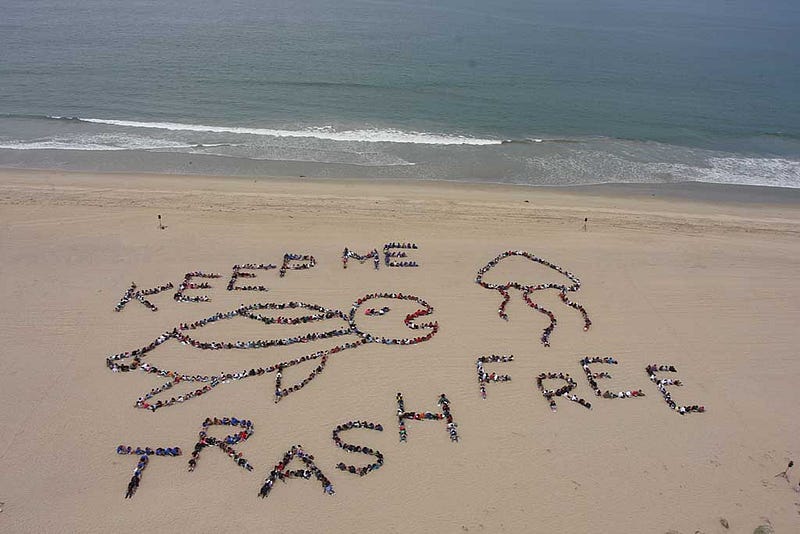
Social Aspects:
As I said in the beginning, the problem of plastic in the oceans is not yet commonly-known. Unfortunately, microplastic does not appear often enough in campaigns and media. That’s why it is crucial to reach a higher level of awareness about this issue.
On the coastal areas, it is easier because microplastic is becoming more and more an issue in the fishing industry and the tourism sector. People are aware of the high amount of microplastic on the beach and shores, demanding “clean” beaches for vacations. Also, the “fresh” fish, especially tourists become more suspicious about fresh fish because of the sea animals’ contamination.
It is necessary to take care of the so-called hotspots. Hotspots are places, where a high amount of microplastic can be found. With surveys and scientific reports, it’s important to find the hotspots of microplastic and raise people’s awareness about this issue and start with educational programs. Hoping on the one hand that the idea will spread and on the other hand trying to act most efficiently.
Trying to analyze the interaction between the different entities, many scientists use the DPSIR. It aim to show the relation between the different actors in marine pollution, their issues and their impact on the system.
In case of the microplastic issue the drivers are the factories producing primary microplastic and any consumer of plastic, which degrades to secondary microplastic. The pressure of the effects on the marine environment I’ve explained previously, is increasing, until a certain state is accomplished. Furthermore, the impact is influencing the environment and make the people aware of this issue. On these grounds, there are responses, e.g. activities from NGOs, other voluntary work etc. The more intense the pressure is (and the following steps), the more intense are the responds from the responding entities, which are trying to lower the pressure. Besides that, there is always this discrepancy between driving entity and responding entity, because they share the most ambivalent points of view.
Referring to the DPSIR model the state, and the impact is the highest and therefore the response the strongest at these hotspots. They need to realize in these hotspots first that they will damage themselves if they don’t take action now!
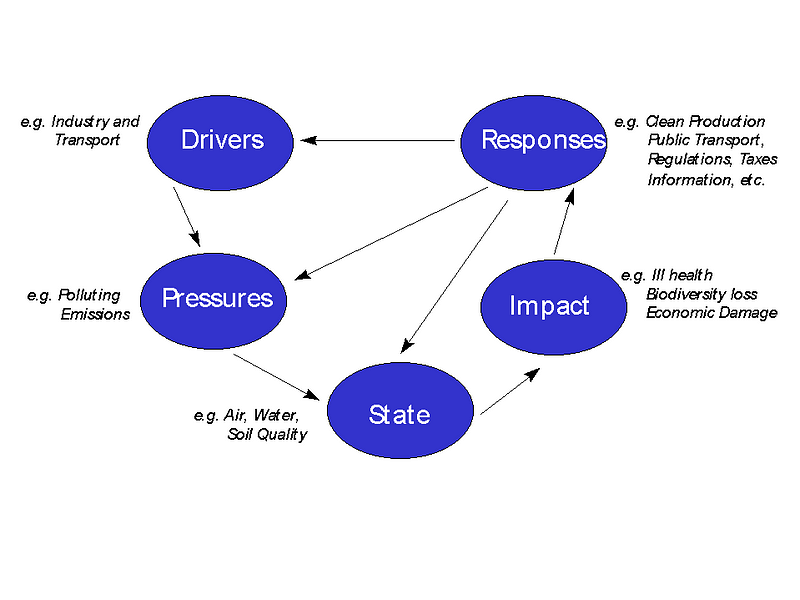
Especially for these educational programs, it is important to teach the difference between primary and secondary microplastic. Both have a major influence and both can be reduced easily by everyone. There are some programs and videos trying to explain the issue in an easy way: https://www.youtube.com/watch?v=BqkekY5t7KY https://www.youtube.com/watch?v=uAiIGd_JqZc
This kind of informal education is as important as formal education. It is the safest way to teach students in a formal way but it’s still interesting enough to motivate people to take action due to informal education. Campaigns like the beach clean-up day, which result from informal education programs, are very popular and efficient. Informal education is also very important to build up a community that grows, connects and helps each other as well as make the people feel that they can actually change something. Reacting to a faster-moving industry than ever, and fast progress in technology, people feel unable to make a difference at all. But this topic is mainly about consumption. Only a small part of pollution is caused directly by factories (e.g. lost pellets on the sea). Most of microplastic exists because of choices in daily life.
In order to create suitable campaigns for special target groups and areas more surveys, and social and psychological investigations are needed. Some of them are already circulating and should be supported.
“Beat the Microbead” is a platform with a huge archive of products containing microplastic and valuable information. There is also a Global Microplastic Intitiative collecting data of samples containing microplastic.
There are several campaigns in different countries, especially Germany and northern european countries that show a lot of engagement.
All in all the fight against microplastic is still at its beginning. The scientific investigations as well as the campaigns, educational programs, and voluntary movements are still in their baby shoes and hopefully will be improved in the future. Useful investigations only started in the 2000’s and this whole topic is very young. Therefore it is even more important to spread the word. That was the major goal of this article. To make you realize that something exists out there in the ocean and at the beach.You probably don’t see it at first but it has a major influence on you, the economy, and especially the marine environment.
